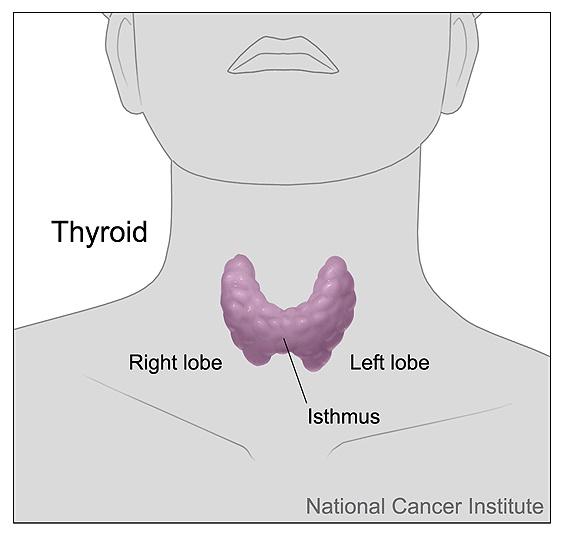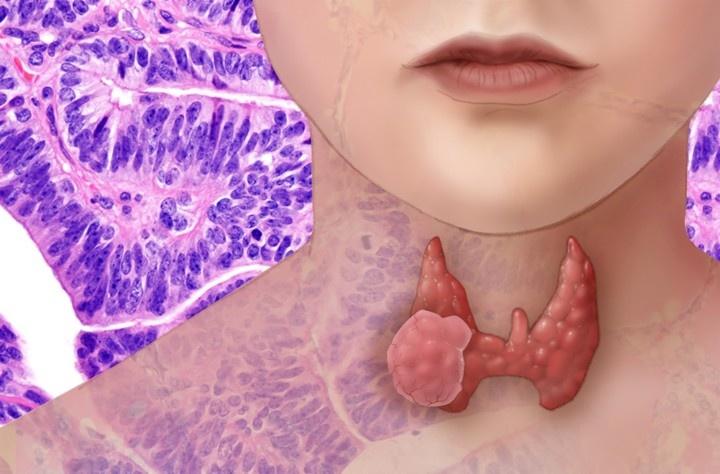The Thyroid
The thyroid is a butterfly-shaped gland in front of your neck. It consists of two lobes and is around two inches long. Although it is small, the thyroid plays an important role in regulating the growth and development of the human body. It also controls how your body uses energy.
There are two types of cells that make up the thyroid: follicular cells and parafollicular C cells. These cells produce and release different hormones. Hormones are substances that tell other organs in our body what to do. Like messengers, they travel around the body to deliver specific instructions.
The C Cells are located in the upper parts of the two lobes, and they are responsible for releasing a hormone called calcitonin. Calcitonin helps regulate how much calcium there is in our blood. Calcium has many roles in our body and can help us do things like build strong, healthy bones.
When the C Cells grow out of control, they can form an abnormal growth called a tumor. This can lead to a type of thyroid cancer called Medullary Thyroid Cancer.
Medullary Thyroid Cancer (MTC)
There are four types of thyroid cancer: papillary, follicular, anaplastic, and medullary. Medullary thyroid cancer (MTC) is relatively rare and accounts for around 4% of all thyroid cancers. An increased risk for MTC can either be passed down in a family, or the disease can occur on its own. 25% of all MTC cases run in families and are usually related to a condition called multiple endocrine neoplasia type 2 (MEN2).
What is Multiple Endocrine Neoplasia type 2 (MEN2) and where does it come from?
MEN2 is a disorder that arises when a family carries changes in the RET gene. Many people with MEN2 will develop MTC. In addition to causing MTC, MEN2 can cause problems in other parts of the body such as the adrenal gland and bones.
There are two types of MEN2:
People with MEN2A have a high chance of developing MTC as well as tumors of the adrenal and parathyroid glands. As a result, side effects of MEN2A can include high blood pressure and kidney stones. It is also known as MEN2A syndrome, multiple endocrine adenomatosis type 2A, multiple endocrine neoplasia type 2A syndrome, and Sipple syndrome.
Nearly all people with MEN2B will develop MTC. It will also predispose you to tumors of the adrenal gland but not of the parathyroid gland. Often times, MTC will develop at a very early age in people with MEN2B. People with MEN2B also develop abnormal growth of nerve tissue (neuromas) in the mouth or GI tract. In some cases, it may lead to a Marfanoid habitus. It is also known as MEN2B syndrome, multiple endocrine adenomatosis type 2B, and multiple endocrine neoplasia type 2B syndrome.
Why the MEN2/MTC Clinic?
While there are drugs that can help with advanced MTC, the biology behind the disease is still not completely clear. This clinic can help improve our understanding of how MTC arises in patients with MEN2. Through obtaining biological samples such as saliva and/or blood, we hope to determine differences in the makeup of tumor samples at DNA/RNA/protein levels.
We would also like to improve our understanding of how MEN2 develops, both in the presence and absence of MTC. This way, we can develop more effective treatment protocols for MEN2 and MTC in the future.
The Medullary Thyroid Carcinoma (MTC) Registry Consortium is partnering with the American Thyroid Association (ATA) to create a registry (list) of all new cases of MTC diagnosed in the United States over the next 10-15 years (the MTC Registry). The purpose of the MTC Registry is to help better understand what risk factors are associated with the development of MTC.

